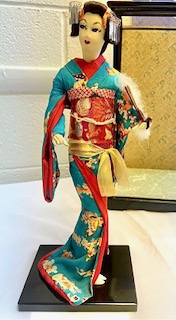
Tokyo Rose Doll – Silent Auction
We are doing a silent auction for this antique Japanese doll now through the end of summer. You can place your bid in person at our museum during normal business hours Fridays and Saturdays from 11am-3pm, or at our Speaking Series events which are the first Sundays of the month through November from 1-3pm.
About This Item
This doll is estimated to have been made around the mid-20th century by Nishi & Co Ltd. Little information on this company has been discovered as it faded into obscurity after the 1970’s. The most accurate documentation about the dolls comes from Tokubei Yamada’s 1955 book “Japanese Dolls” aimed for Japan’s tourism trade. It is known that many of these dolls were mass produced by Japanese citizens as community activities to sell for their recovering country.
History
WWII Crafts: Japanese Traditional Doll Construction
In his 1955 overview, Japanese Dolls, Tokubei Yamada suggests that in the postwar period amateur dollmakers rivaled the professionals; though they could not manipulate the traditional materials without the intense apprenticeships required of professionals, they discovered new materials, and methods for achieving their vision.
Another type of doll which seems to have developed as a home craft is the sakura ningyo (“cherry blossom doll”‘), which may also be called a silk-skinned or mask-faced doll. These became popular in the 1920s and 1930s and were originally made to represent Western film stars (furansu ningy or “French dolls”). The Japanese versions usually represent traditional “floating world” subjects like kabuki roles or Edo-period women engaged in musical or domestic activities. The kits would include a stiffened cloth mask, sometimes with the face already painted on it, a stuffed body and separate wired arms and legs, and patterns for clothing; accessories could be purchased at the same stores or “schools of doll-making.” The face had to be painted and the clothing assembled; the wired limbs allowed the doll to be posed. After World War II, this type of doll became a favorite souvenir for Americans, and they were produced professionally. The art continued to develop with the use of new materials, but the more elaborate doll subjects moved out of the sphere of the home.
Names for this type of doll include:
- Isho-bina or isho-ningyo: costume doll (a very broad designation that includes genre dolls of any kind)
- Ukiyo-ningyo: floating world doll
- Oyama ningyo: doll representing a female Kabuki role
- Kyoto ningyo: Kyoto doll (even though many types of dolls were made in Kyoto; see Gribbins, Japanese Antique Dolls)
- Sakura ningyo: cherry blossom doll (for the silk-faced dolls)
- Ukiyo-e, “floating world pictures”
The 18th and 19th century produced in Japan an art form, Ukiyo-e, representing the “floating world” -an ephemeral life of pleasure and emotion, repugnant to Buddhist philosophy, but dear to the hearts of young men and essential to the economy and society of feudal Japan. This was the world of the Kabuki theater, with its favorite actors and their fans, and of the geisha (“talented persons” trained in music and dance) and the oiran (the most admired of the whores in the brothel zones or “pleasure quarters” of the big cities), who presided over salons for elegant social intercourse as well as sexual intercourse.
Play dolls and baby dolls were certainly loved by the geishas and brothel-dwellers themselves and were as fashionable as all their other pastimes. So there was interaction in the development of many kinds of dolls as children’s toys were modified to suit courtesans and vice versa. The jointed ichimatsu play doll was originally the effigy of a Kabuki actor (he was called Ichimatsu because it means “checked,” referring to a costume he wore in an important role)-a delightful gift for a young dancer or favored mistress.
As the floating world floated away in the 20th century, doll art commemorated the beauties and beloved dramatis personae of the Ukiyo. While earlier dolls had often represented the male roles in Kabuki, now the onnagata, or actor portraying a woman, was more likely to be represented. The onnagata usually perform dance solos which are the emotional core of the play, and these are the moments memorialized in the dolls.
